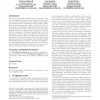146 search results - page 2 / 30 » A Comparison of Bloat Control Methods for Genetic Programmin... |
GECCO
2011
Springer
12 years 8 months ago
2011
Springer
In genetic programming, the reproductive operators of crossover and mutation both require the selection of nodes from the reproducing individuals. Both unbiased random selection a...
GECCO
2008
Springer
13 years 6 months ago
2008
Springer
The parsimony pressure method is perhaps the simplest and most frequently used method to control bloat in genetic programming. In this paper we first reconsider the size evolutio...
GECCO
2008
Springer
13 years 6 months ago
2008
Springer
Determining if a group of proteins are functionally associated among themselves is an open problem in molecular biology. Within our long term goal of applying Genetic Programming ...
EUROGP
2005
Springer
13 years 10 months ago
2005
Springer
Abstract. Cartesian Genetic Programming is a graph based representation that has many benefits over traditional tree based methods, including bloat free evolution and faster evolu...
CEC
2003
IEEE
13 years 10 months ago
2003
IEEE
Abstract- The Maximum Homologous Crossover attempts to preserve similar structures from parents by aligning them according to their homology. In this paper, it is successfully test...

